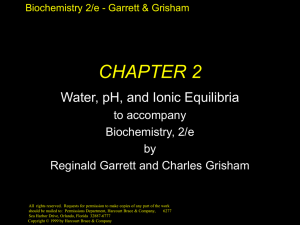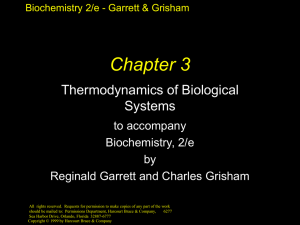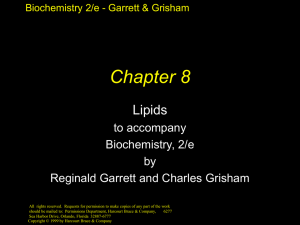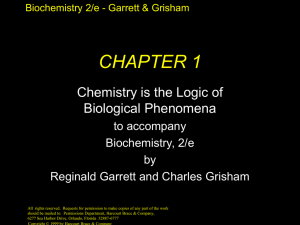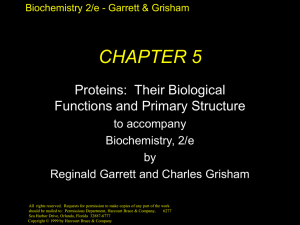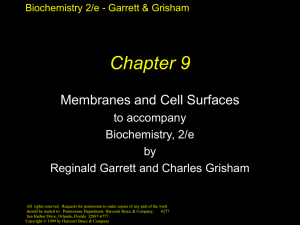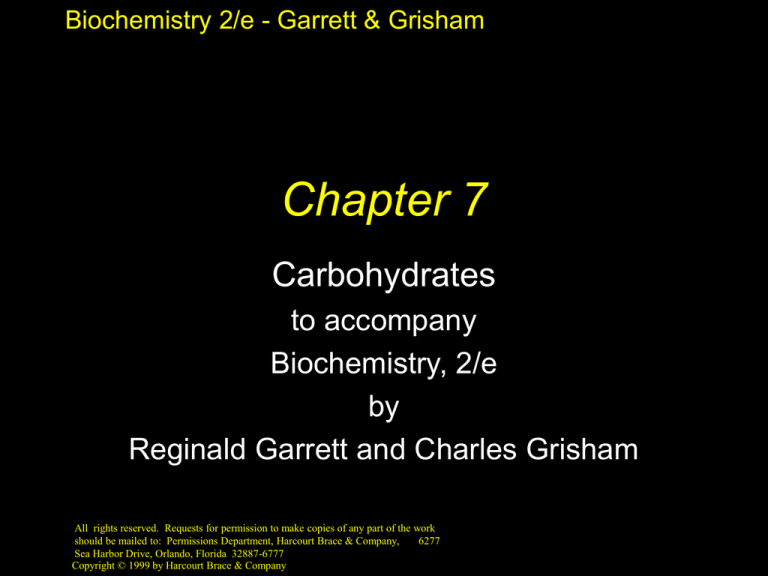
Biochemistry 2/e - Garrett & Grisham
Chapter 7
Carbohydrates
to accompany
Biochemistry, 2/e
by
Reginald Garrett and Charles Grisham
All rights reserved. Requests for permission to make copies of any part of the work
should be mailed to: Permissions Department, Harcourt Brace & Company,
6277
Sea Harbor Drive, Orlando, Florida 32887-6777
Copyright © 1999 by Harcourt Brace & Company
Biochemistry 2/e - Garrett & Grisham
Outline
•
•
•
•
7.1 Carbohydrate Nomenclature
7.2 Monosaccharides
7.3 Oligosaccharides
7.4 Polysaccharides
Copyright © 1999 by Harcourt Brace & Company
Biochemistry 2/e - Garrett & Grisham
7.1 Nomenclature
Carbohydrates are hydrates of carbon
• Monosaccharides (simple sugars)
cannot be broken down into simpler
sugars under mild conditions
• Oligo = "a few" - usually 2 to 10
• Polysaccharides are polymers of the
simple sugars
Copyright © 1999 by Harcourt Brace & Company
Biochemistry 2/e - Garrett & Grisham
7.2 Monsaccharides
•
•
•
•
An organic chemistry review
Aldoses and ketoses contain aldehyde and
ketone functions, respectively
Triose, tetrose, etc. denotes number of
carbons
Aldoses with 3C or more and ketoses with
4C or more are chiral
Review Fischer projections and D,L system
Copyright © 1999 by Harcourt Brace & Company
Biochemistry 2/e - Garrett & Grisham
Copyright © 1999 by Harcourt Brace & Company
Biochemistry 2/e - Garrett & Grisham
Copyright © 1999 by Harcourt Brace & Company
Biochemistry 2/e - Garrett & Grisham
Copyright © 1999 by Harcourt Brace & Company
Biochemistry 2/e - Garrett & Grisham
Stereochemistry Review
•
•
•
•
Read text on p. 210-213 carefully!
D,L designation refers to the configuration of
the highest-numbered asymmetric center
D,L only refers the stereocenter of interest
back to D- and L-glyceraldehyde!
D,L do not specify the sign of rotation of
plane-polarized light!
All structures in Figures 7.2 and 7.3 are D
• D-sugars predominate in nature
Copyright © 1999 by Harcourt Brace & Company
Biochemistry 2/e - Garrett & Grisham
Copyright © 1999 by Harcourt Brace & Company
Biochemistry 2/e - Garrett & Grisham
More Stereochemistry
•
•
•
•
Know these definitions
Stereoisomers that are mirror images of each
other are enantiomers
Pairs of isomers that have opposite
configurations at one or more chiral centers
but are NOT mirror images are diastereomers
Any 2 sugars in a row in 10.2 and 10.3 are
diastereomers
Two sugars that differ in configuration at only
one chiral center are epimers
Copyright © 1999 by Harcourt Brace & Company
Biochemistry 2/e - Garrett & Grisham
Cyclic monsaccharide
structures and anomeric forms
• Glucose (an aldose) can cyclize to form
a cyclic hemiacetal
• Fructose (a ketose) can cyclize to form
a cyclic hemiketal
• Cyclic form of glucose is a pyranose
• Cyclic form of fructose is a furanose
Copyright © 1999 by Harcourt Brace & Company
Biochemistry 2/e - Garrett & Grisham
Copyright © 1999 by Harcourt Brace & Company
Biochemistry 2/e - Garrett & Grisham
Copyright © 1999 by Harcourt Brace & Company
Biochemistry 2/e - Garrett & Grisham
Cyclic monsaccharide
structures and anomeric forms
• Cyclic forms possess anomeric carbons
• For D-sugars, alpha has OH down,
beta up
• For L-sugars, the reverse is true
Copyright © 1999 by Harcourt Brace & Company
Biochemistry 2/e - Garrett & Grisham
Copyright © 1999 by Harcourt Brace & Company
Biochemistry 2/e - Garrett & Grisham
Copyright © 1999 by Harcourt Brace & Company
Biochemistry 2/e - Garrett & Grisham
Copyright © 1999 by Harcourt Brace & Company
Biochemistry 2/e - Garrett & Grisham
Monosaccharide Derivatives
• Reducing sugars: sugars with free
anomeric carbons - they will reduce
oxidizing agents, such as peroxide,
ferricyanide and some metals (Cu and Ag)
• These redox reactions convert the sugar to
a sugar acid
• Glucose is a reducing sugar - so these
reactions are the basis for diagnostic tests
for blood sugar
Copyright © 1999 by Harcourt Brace & Company
Biochemistry 2/e - Garrett & Grisham
Copyright © 1999 by Harcourt Brace & Company
Biochemistry 2/e - Garrett & Grisham
More Monosaccharide
Derivatives
• Sugar alcohols: mild reduction of sugars
• Deoxy sugars: constituents of DNA, etc.
• Sugar esters: phosphate esters like ATP
are important
• Amino sugars contain an amino group in
place of a hydroxyl group
• Acetals, ketals and glycosides: basis for
oligo- and poly-saccharides
Copyright © 1999 by Harcourt Brace & Company
Biochemistry 2/e - Garrett & Grisham
Copyright © 1999 by Harcourt Brace & Company
Biochemistry 2/e - Garrett & Grisham
Copyright © 1999 by Harcourt Brace & Company
Biochemistry 2/e - Garrett & Grisham
Copyright © 1999 by Harcourt Brace & Company
Biochemistry 2/e - Garrett & Grisham
Copyright © 1999 by Harcourt Brace & Company
Biochemistry 2/e - Garrett & Grisham
Copyright © 1999 by Harcourt Brace & Company
Biochemistry 2/e - Garrett & Grisham
Copyright © 1999 by Harcourt Brace & Company
Biochemistry 2/e - Garrett & Grisham
Copyright © 1999 by Harcourt Brace & Company
Biochemistry 2/e - Garrett & Grisham
7.3 Oligosaccharides
•
•
•
•
Don't memorize structures, but know the
important features
Be able to identify anomeric carbons and
reducing and nonreducing ends
Sucrose is NOT a reducing sugar
Browse the structures in Fig. 7.19 and
Figure 7.20
Note carefully the nomenclature of links! Be
able to recognize alpha(1,4), beta(1,4), etc
Copyright © 1999 by Harcourt Brace & Company
Biochemistry 2/e - Garrett & Grisham
Copyright © 1999 by Harcourt Brace & Company
Biochemistry 2/e - Garrett & Grisham
Copyright © 1999 by Harcourt Brace & Company
Biochemistry 2/e - Garrett & Grisham
Copyright © 1999 by Harcourt Brace & Company
Biochemistry 2/e - Garrett & Grisham
7.4 Polysaccharides
•
•
•
•
Functions: storage, structure, recognition
Nomenclature: homopolysaccharide vs.
heteropolysaccharide
Starch and glycogen are storage
molecules
Chitin and cellulose are structural
molecules
Cell surface polysaccharides are
recognition molecules
Copyright © 1999 by Harcourt Brace & Company
Biochemistry 2/e - Garrett & Grisham
Starch
A plant storage polysaccharide
• Two forms: amylose and amylopectin
• Most starch is 10-30% amylose and 7090% amylopectin
• Branches in amylopectin every 12-30
residues
• Amylose has alpha(1,4) links, one
reducing end
Copyright © 1999 by Harcourt Brace & Company
Biochemistry 2/e - Garrett & Grisham
Copyright © 1999 by Harcourt Brace & Company
Biochemistry 2/e - Garrett & Grisham
Starch
A plant storage polysaccharide
• Amylose is poorly soluble in water, but
forms micellar suspensions
• In these suspensions, amylose is helical
– iodine fits into the helices to produce a blue
color
Copyright © 1999 by Harcourt Brace & Company
Biochemistry 2/e - Garrett & Grisham
Copyright © 1999 by Harcourt Brace & Company
Biochemistry 2/e - Garrett & Grisham
Why branching in Starch?
Consider the phosphorylase reaction...
• Phosphorylase releases glucose-1-P
products from the amylose or amylopectin
chains
• The more branches, the more sites for
phosphorylase attack
• Branches provide a mechanism for quickly
releasing (or storing) glucose units for (or
from) metabolism
Copyright © 1999 by Harcourt Brace & Company
Biochemistry 2/e - Garrett & Grisham
Copyright © 1999 by Harcourt Brace & Company
Biochemistry 2/e - Garrett & Grisham
Glycogen
•
•
•
•
•
The glucose storage device in animals
Glycogen constitutes up to 10% of liver
mass and 1-2% of muscle mass
Glycogen is stored energy for the organism
Only difference from starch: number of
branches
Alpha(1,6) branches every 8-12 residues
Like amylopectin, glycogen gives a redviolet color with iodine
Copyright © 1999 by Harcourt Brace & Company
Biochemistry 2/e - Garrett & Grisham
Dextrans
A small but significant difference from
starch and glycogen
• If you change the main linkages
between glucose from alpha(1,4) to
alpha(1,6), you get a new family of
polysaccharides - dextrans
• Branches can be (1,2), (1,3), or (1,4)
Copyright © 1999 by Harcourt Brace & Company
Biochemistry 2/e - Garrett & Grisham
Copyright © 1999 by Harcourt Brace & Company
Biochemistry 2/e - Garrett & Grisham
Dextrans
A small but significant difference from
starch and glycogen
• Dextrans formed by bacteria are
components of dental plaque
• Cross-linked dextrans are used as
"Sephadex" gels in column
chromatography
• These gels are up to 98% water!
Copyright © 1999 by Harcourt Brace & Company
Biochemistry 2/e - Garrett & Grisham
Copyright © 1999 by Harcourt Brace & Company
Biochemistry 2/e - Garrett & Grisham
Structural Polysaccharides
Composition similar to storage
polysaccharides, but small structural
differences greatly influence properties
• Cellulose is the most abundant natural
polymer on earth
• Cellulose is the principal strength and
support of trees and plants
• Cellulose can also be soft and fuzzy - in
cotton
Copyright © 1999 by Harcourt Brace & Company
Biochemistry 2/e - Garrett & Grisham
Copyright © 1999 by Harcourt Brace & Company
Biochemistry 2/e - Garrett & Grisham
Structural Polysaccharides
Composition similar to storage
polysaccharides, but small structural
differences greatly influence properties
• Beta(1,4) linkages make all the
difference!
• Strands of cellulose form extended
ribbons
Copyright © 1999 by Harcourt Brace & Company
Biochemistry 2/e - Garrett & Grisham
Copyright © 1999 by Harcourt Brace & Company
Biochemistry 2/e - Garrett & Grisham
Other Structural
Polysaccharides
Further reading - pages 232-235
• Chitin - exoskeletons of crustaceans,
insects and spiders, and cell walls of
fungi
– similar to cellulose, but C-2s are N-acetyl
– cellulose strands are parallel, chitins can
be parallell or antiparallel
Copyright © 1999 by Harcourt Brace & Company
Biochemistry 2/e - Garrett & Grisham
Copyright © 1999 by Harcourt Brace & Company
Biochemistry 2/e - Garrett & Grisham
Other Structural
Polysaccharides
• Alginates - Ca-binding polymers in
algae
• Agarose and agaropectin - galactose
polymers
• Glycosaminoglycans - repeating
disaccharides with amino sugars and
negative charges
Copyright © 1999 by Harcourt Brace & Company
Biochemistry 2/e - Garrett & Grisham
Copyright © 1999 by Harcourt Brace & Company
Biochemistry 2/e - Garrett & Grisham
Copyright © 1999 by Harcourt Brace & Company
Biochemistry 2/e - Garrett & Grisham
Copyright © 1999 by Harcourt Brace & Company
Biochemistry 2/e - Garrett & Grisham
Copyright © 1999 by Harcourt Brace & Company

